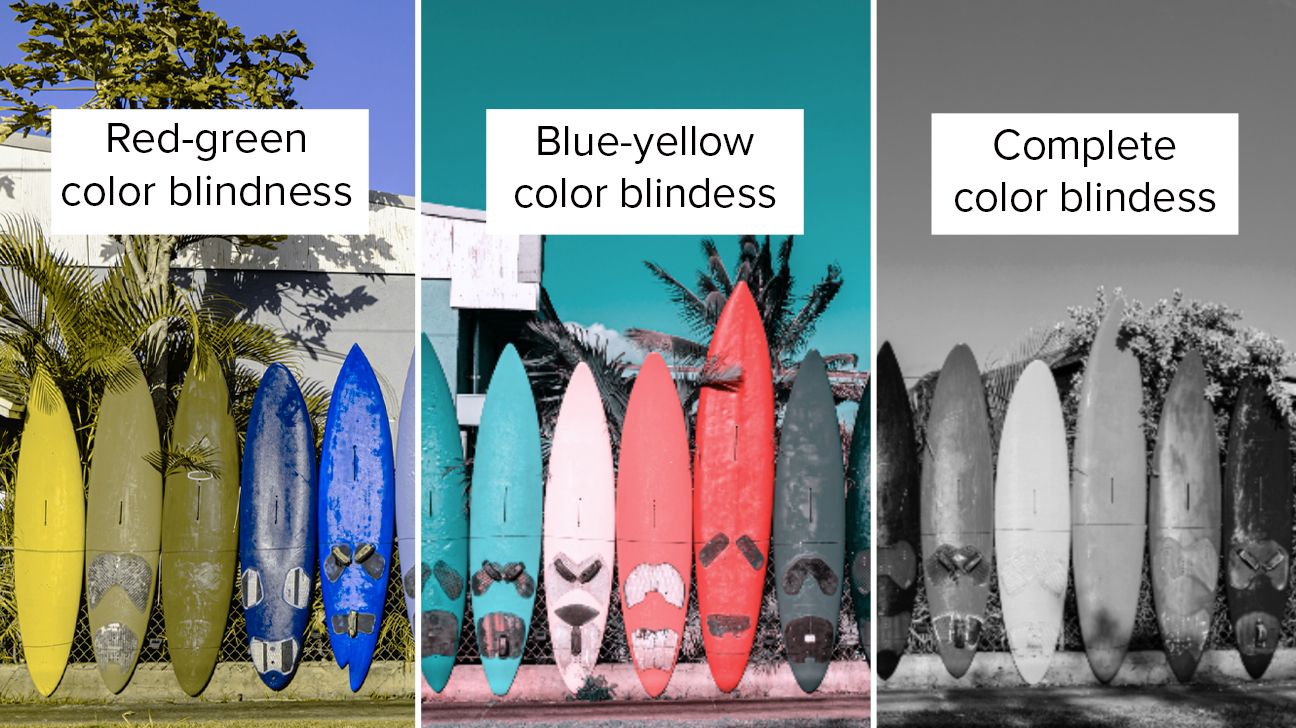There are three main types of color vision deficiency: red-green, blue-yellow, and complete.
Color blindness, or color vision deficiency, affects the way you perceive color and can make it hard to distinguish between certain colors. People typically have three types of cones (M, L, and S) in their eyes. These cones perceive color. People with color vision deficiency may have less sensitive cones or lack certain types of cones.
- With red-green color vision deficiency, some or all shades of red and green may look indistinguishable.
- With blue-yellow color vision deficiency, you might not be able to distinguish blue from green or yellow from violet.
Though much rarer, color vision deficiency can also be complete and have additional symptoms, including sensitivity to light or unclear vision.


People with some forms of color blindness can use visual aids to help them tell the difference between colors.
Keep reading to learn more about the specific types of color blindness and how eye doctors help people manage them.
Red-green color vision deficiency, also known as protan color blindness, is the
Experts further classify red-green color deficiency based on the way they perceive these colors. For instance:
- Deuteranomaly makes some shades of green look more red. This happens if your M cones are less sensitive to green or do not function as they should.
- Protanomaly makes some shades of red look more green. They may also look duller. This happens if your L cones are less sensitive to red or do not function as they should.
- Deuteranopia makes someone unable to see the color green. This happens when someone does not have green cones.
- Protanopia makes someone unable to see the color red. It happens when they do not have red cones.
Red-green color blindness can be genetic and is passed down on the X chromosome. Because of that, it’s more common in people assigned male at birth, who usually have one X and one Y chromosome.
As people assigned female at birth typically have two X chromosomes, they would have to receive the red-green color deficiency gene from both parents in order to have color blindness.
Blue-yellow color vision deficiency is
The two types of blue-yellow color vision deficiency include:
- Tritanomaly affects your ability to distinguish between blue and green and between yellow and red. This happens if your S cones, which help you see blue, have a mutation.
- Tritanopia is more severe and makes you unable to tell the difference between blue and green, purple and red, and yellow and pink. It may also make colors look duller. This happens if you do not have S cones.
Blue-yellow color blindness can be genetic. It’s inherited in the autosomal dominant pattern. This means a person only needs one copy of the defective gene (OPN1SW) to have it.
Achromatopsia, or rod monochromatic, is rare and causes color vision deficiency with all three cone types and issues with the retina. People with this vision difference mostly see black, gray, and white.
There are two types:
- Complete achromatopsia causes you to see in monochrome. People may have poor vision with a visual acuity of
20/200 or less . - Incomplete achromatopsia causes people to see mostly in monochrome but with partial colors. People with incomplete achromatopsia may have less severe vision issues than those with complete achromatopsia, with visual acuity of up to 20/80.
Achromatopsia may cause other symptoms, such as:
- blurry vision
- farsightedness, or difficulty seeing things close up
- sensitivity to bright light
- shaking eyes, or nystagmus
Achromatopsia results from issues with certain genes that affect how the cones in the eye work. Affected genes can include:
- ATF6
- CNGA3
- CNGB3
- GNAT2
- PDE6C
- PDE6H
Color vision deficiency is often genetic, though the specific genes involved vary by the type of color blindness.
While complete color blindness or achromatopsia only results from genetic mutations, both red-green and blue-yellow color blindness can also be acquired (or develop) due to other factors. Other causes of these forms of color blindness can include:
- retinal detachment, which happens when the retina separates from the back of the eye, usually due to an underlying health condition
- eye injury during laser eye surgery
- brain tumors that affect or put pressure on the optic nerve
- radiation therapy in an area near the optic nerve
- cataracts, which can worsen color vision
While there isn’t a cure for color vision deficiency, supportive devices are available that may help people distinguish between colors. These may include:
- glasses or contact lenses
- spectrally tuned illumination
- recoloration devices
While most of these studies are focused on animals, there are clinical studies for gene therapy for achromatopsia. However, these studies are still in the early phase.
There are multiple types of color vision deficiency, also known as color blindness.
These include red-green, blue-yellow, and complete color vision deficiency. They differ based on the colors a person with the deficiency can distinguish.
Color vision deficiency usually results from genetic causes, but people may also develop some forms of it because of health conditions that affect the eyes or optic nerve.




